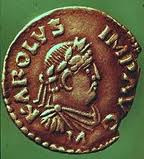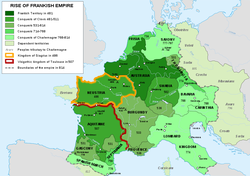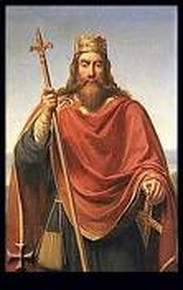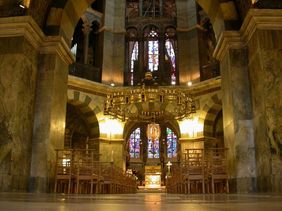Western Europe: Kingdom of the Franks
Economy

The first kingdom to emerge from the devolution of the early Middle Ages was that of the Germanic tribe of the Franks. From 714 to 814, the Carolingian House of the Franks brought stability and progress to northern Europe. A large portion of the West enjoyed military and political security as well as religious unity. However, The Frankish empire did not tolerate, partly because it lacked the strong economic bases that has supported the Romans. By the ninth century, Muslim conquests and commercial activity successfully competed with the Franks; inland trade declined sharply and urban life almost disappeared in the north. In addition, the empire had no strong administrative machinery to make up for the weak rulers who followed the dominating leadership of the emperor Charlemagne.
Government

In 486, Clovis I, king of the Franks, conquered the former Roman province of Gaul. He ruled his new lands according to Frankish customs and traditions and didn't preserve much of the Roman legacy of Gaul. Clovis divided his empire between his four sons who in turn divided their empires between their sons and grandsons. The Frankish realm was united again by Chlothar II. Germanic laaw mostly consisted of private law, which was concerned with protecting individuals over public law which protected the interest of the state. A system of government sometimes referred to as feudalism attempted to provide stability and to serve as an effective political substitute for a powerful effective central government.
Culture

The language spoken by the Franks was Old Frankish. There were two major religions that were prominent in the Frank Kingdom: Paganism and Christianity. Although it is not known for sure, Frankish Paganism shared many values and characteristics with Germanic paganism. The Frankish Pagans performed many rituals and their day-today activities revolved aroung their gods. Some Franks converted to Christianity. At the time, the Franks were the only Christianized Germanic tribe without an Arrian aristocracy. This led to a very healthy relationship between the Franks and the Church of Rome. The majority of Christian conversions in the Frank Kingdom were a result of the conversion of Clovis I to Christianity.
Innovations

There were two major periods of art in the Frank Kingdom: Merovingian and Carolingian. Most of the art from the Merovingian period has been lost. The most completely surviving example of Merovingian architecture is a baptistery dedicated to Saint John in Poitiers. Other small baptistries and churches have also survived but have been damaged. Examples of the arts that have been preserved from the Merovingian period are weapons, jewelry, and apparel. Frankish art displayed many antique style motifs.
The main surviving example of Carolingian architecture is the Palatine Chapel in Aachen. Many Carolingian illuminated manuscripts and ivory plaques survive today.
The main surviving example of Carolingian architecture is the Palatine Chapel in Aachen. Many Carolingian illuminated manuscripts and ivory plaques survive today.
